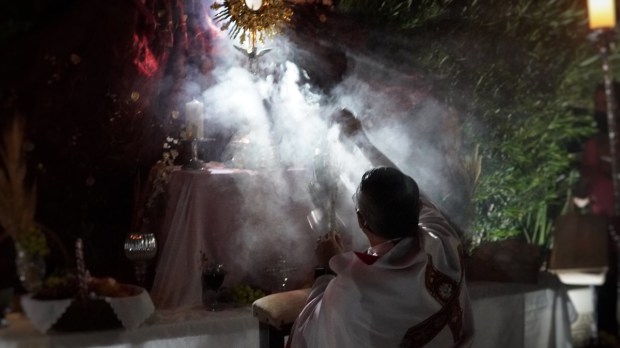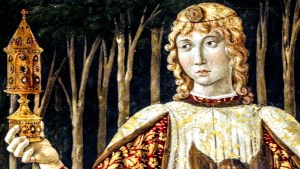I love searching out online videos of monks making incense with their super-secret, special recipes that have been handed down from brother to brother in the monastery from time unknown. The care with which they craft it reveals how special incense really is and how vital to our worship. It seems like a peaceful but holy process, to be a monk quietly blending incense in some outbuilding of the monastery. When I burn it at the altar during Mass, I’ve always appreciated the result.
The calming fragrance and the effect it has on those who smell it are difficult to explain. When I’m at Mass my heartbeat slows down just a little bit, and the weight of the world slips off my shoulders. A church with incense in the air is overshadowed, marked out as sacred space. The stones exhale the perfume of countless Masses. It’s the fragrance of prayer.
Sacred worship engages all our senses, including smell. The odor in a Catholic church seems a small detail, but I still recall the time a child came into our church with his mother and, as soon as they crossed the threshold, excitedly whispered in her ear, “It smells like church in here!”
We engage in worship with our whole selves – sight, taste, touch, hearing, and smell. The beauty soaks into our soul and is internalized. We too ought to “smell like church” through our actions as we go about our daily lives.
What does incense symbolize?
There are various ways to explain the symbolic meaning of incense. The most simple is to note that it’s a visible sign of prayers rising to our Heavenly Father. We literally see the incense consumed in fire and climbing to God as a pillar of smoke. St. John affirms this symbolism when he sees the angels in the throne room of Heaven, “holding golden bowls full of incense, which are the prayers of God’s people.” (Rev 5:8)
Incense is far more than prayer made visible, though. It is a sacrifice. If you’ve ever watched those videos of monks preparing it, you’ve witnessed how it is ground down to pieces with mortar and pestle. It is crushed. Then, at the altar, it is burned away entirely.
In the old covenant, God commanded the construction of an altar specifically dedicated to burning incense (Exodus 30:1). Priests sacrificed incense on this altar twice a day, once in the morning and once in the evening. Once per year, incense was also a required part of the atonement sacrifice. The atonement is the offering that Christ fulfills at the Cross. It is the offering for the forgiveness of sins.
This is precisely why it is laudable to burn incense during the Holy Sacrifice of the Mass every Sunday. Incense is present in the Temple sacrifices and also present in Heavenly worship, so it’s only fitting that we use it in our current worship.
Worship that penetrates the heart
Remember, worship isn’t only an exterior action. It always goes to the heart. St. Gregory the Great encourages us to think of our hearts as altars from which to burn incense. We are meant to exhale sweet fragrances before God.
St. Robert Southwell, while imprisoned in the Tower of London awaiting his death in Elizabethan England for the crime of being a Catholic priest, composed a poem in which he compares his life to the incense sacrifice. In Decease, Release, he writes, “God’s spice I was and pounding was my due/ In fading breath my incense savored best.” His life was given to God in martyrdom and only then did it release its fragrant perfume. This is the beauty of sacrifice.
We must never forget, though, that the sacrifice is Our Lord’s and we are but joining him. Here’s where the symbolism of incense becomes really interesting.

Why incense is the “perfume of the sun”
Jean Hani, in his book The Symbolism of the Christian Temple, says, “incense is the perfume of the sun.” This is because incense is a resin created by the frankincense tree in cooperation with the action of sunshine. When you take a piece of incense between your fingers and hold it up to the sky, it is amber-colored, transparent, and refracts the sunshine. It’s almost like a piece of crystallized light.
The ancients believed that incense is born of the sun, born of fire. It also dies by fire when consumed at the altar. A grain of incense is a piece of earth transformed into heaven through the action of being sacrificed. Humanity undergoes this same transformation at the Cross. Our Lord joins lowly humanity to himself and, as our representative, makes a perfect sacrifice. He lifts us up to Heaven through grace. That is, if we make our lives a sacrifice along with him.
For years, when the schoolchildren in my parish asked why I made a circling motion with the thurible around the bread and wine during Mass, I shrugged. I didn’t know. I simply incensed the altar the way the diagrams in the liturgy books show. Now I understand that the circle is tracing out the shape of the sun.
The circular motion is preceded by incensing the gifts with the sign of the cross three times. Inscribing the crucifix over the bread and wine indicates that the effects of Cross will travel to the ends of the earth – east, west, north, and south – and then the circling motion is made around the area the crosses were made. The love of Christ will fill everything between the rising and setting sun. In fact, he is that rising sun. He is the light of the world.
A visible sign
In many ancient churches, the incense sacrificed at the altar floats upwards to the cornerstone of the arch above it. It’s a ladder to Heaven, a visible sign that the earth is being redeemed, raised up as an offering to Our Father. Christ is that vertical line. He is at the foundation stone of the altar and also at the cornerstone at the roof of the world. Indeed, his light travels on through that roof, on past the sun and other stars into the celestial realm.
The more I understand about the mysteries of the liturgy, the more it fits together in a beautiful, harmonious whole. The symbols of the Mass can be difficult to understand. Many of the traditions of the Church are darkly mysterious. At the heart of it all Christ shines brightly, like the sun.
A season of light and dark
Sometimes our lives seem as though we’re walking through a shadowed valley. We don’t know what the future holds. We harbor doubts and God’s ways are dim. In late winter, the world mimics our inner darkness. In December, the days grow shorter and night falls heavy in the northern hemisphere. It is precisely in the onset of this outer darkness that the Church celebrates the arrival of her new year, Advent.
Advent is a season of light and dark, a time of waiting and watching. Our Lord will be born at Christmas in the dead of night, in the depths of a cave, but outside the sky rips open in glory as angels shine in majesty. From the moment of Christ’s birth, the days begin to lengthen as the light of the world gains in power and glory, but down in the darkness is the Holy Family.
In the stone crib shaped like an altar, Our Lord is wrapped in swaddling clothes and lies like a perfect grain of incense ready to be crushed and consumed by the fire of his love. The perfume of the Son is finally released.



